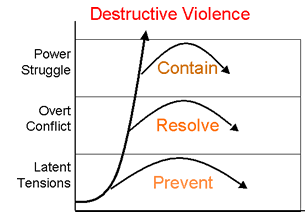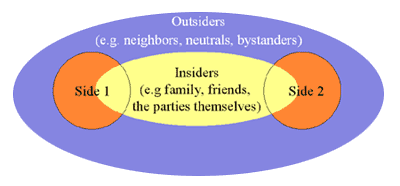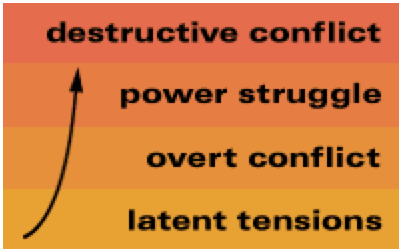Equalizer – Democratize Power
Every conflict takes place within the larger context of power. Imbalance of power often leads to abuse and injustice. The strong refuse to negotiate with the weak or to submit their dispute to mediation or arbitration — why should they, they think, when they can win? This is where the Equalizer has a contribution to make. Each of us holds a packet of power, a measure of influence over the parties around us. Individuality, our influence may be small, but collectively, it can be considerable. We are capable of empowering the weak and the unrepresented so that they can negotiate a fair and mutually satisfactory resolution.
Help bring the powerful to the table
Each of us has opportunities to use our influence to bring about productive negotiations:
- A parent can equalize the power between a younger and an older child, insisting that they reach an agreement fair to both.
- A boss can direct a more powerful department head to negotiate an even-handed resolution with a weaker rival.
- A chorus of newspaper editorials can promote talks between an unwilling company and its union, or vice versa.
- The neighbors of a country torn by civil war can exercise diplomatic peer pressure on that country’s reluctant government to sit down with the rebels.
Ensuring that the weak and the unrepresented sit as equals at the table is just the first step, of course. As Thirdsiders, we often need to remain involved so that the parties reach an equitable agreement – and carry it out.
- The job, for instance, of an organizational ombudsperson, who typically reports directly to the CEO, is to balance the power between a weaker employee (or customer) and someone more powerful inside the organization, such as a supervisor, so that the issue – racial discrimination, sexual harassment, or less serious matters – can be fairly addressed and a resolution fully implemented.
Build collaborative democracy
Stepping in to bring about a negotiation only temporarily equalizes the power balance. More sustainably, we as Thirdsiders can build democracy and promote the fair sharing of power.
Creating collaborative democracy helps handle difficult disputes, starting at home. Democratic family meetings can air contentious issues and allow creative agreements to be worked out.
- “We sit down maybe once a month, tears are shed, and we talk and air it out,” explains one father of a family of six. Parents and children participate as equals in such meetings, helping make decisions such as how to distribute chores fairly or where to go for a family vacation. It is not easy to share power, but it can work – if people learn to take the Third Side.
Collaborative democracy can be used in schools as well:
- The most effective strategy for preventing violence in American schools turns out not to be installing metal detectors but rather involving students in a problem-solving process. Adults frequently do not understand the depth of adolescent passions or what sets them off – the insults, the pressure to conform, the teasing in the school shower. Fellow students can understand and often have better ideas for what will work to resolve the problem.
- At one school cafeteria where fights were breaking out regularly on the lunch line, for example, students suggested creating two separate lines, one for pizza and the other for salad. The fighting stopped.
Building democracy can also help end wars:
- The violence ceased in Italy when the German-speaking minority was accorded autonomy in the 1970s.
- Malaysia, once torn by ethnic strife between ethnic Malays and Chinese in the 1950s and 1960s, learned to share power between the two communities and came to enjoy civil peace and prosperity in the 1970s and 1980s.
- A great experiment took place to end the thirty-year civil war in Northern Ireland. In May 1998, the people of the entire island, North and South, voted together for the first time. Acting as Thirdsiders, the great majority of them voiced their support for a peaceful solution through political power-sharing among Protestants and Catholics in the North. “The conflict isn’t over,” reflected one hopeful citizen on a radio talk show, “but the war is.”
Support nonviolent action
Sometimes people resort to violence out of desperation, believing there is no other way to address their needs. Even in a democracy, the formal mechanisms of government may be insufficient to correct injustices. It is up to us as Thirdsiders to show that nonviolent action can work instead. Indeed, community support is the key mechanism through which nonviolent action ultimately achieves its goals.
No one has done more to develop and popularize the tool of nonviolent action than Mahatma Gandhi:
- At the beginning of the twentieth century, Gandhi was determined to free India from centuries of British rule; he was equally determined to do so without using violence. At the time, most people thought his enterprise laughable. How could one man take on the British empire, the largest empire on the face of the earth? How many battalions did Gandhi command? his opponents asked contemptuously. But over time Britain weakened and grew weary with the costs of empire, whereas Gandhi only grew stronger.
- Gandhi carefully crafted a strategy for measuring power in terms of the willingness of people to suffer for their cause – without inflicting violent harm on their adversaries. Through such nonviolent actions as breaking unjust laws and flooding the jails of colonial India, boycotting English textiles, provoking the wrath of the occupiers, and accepting whatever violent punishment they meted out, he persuaded a nation infinitely more powerful in conventional military terms to withdraw peacefully from a country it had occupied for four hundred years.
- Gandhi succeeded by mobilizing the community itself, millions of Indians from all walks of life. He also aroused widespread sympathy and support for his cause around the world, including in Great Britain itself. The Third Side, both outside and inside India, served to hold in check those British officials who counseled using massive force to put an end on Gandhi and his followers.
Gandhi’s efforts have inspired the use of nonviolent action around the world:
- During the 1960s, Martin Luther King, Jr., led the American civil rights movement in an effective nonviolent campaign to obtain equal rights for black Americans.
- During the 1980s, nonviolent protests in Poland, East Germany, and Czechoslovakia, orchestrated by labor unions, churches, and other civil institutions, helped bring an end to communist dictatorship.
In all these cases, the wider public became engaged as Thirdsiders and helped equalize the power between the weak and the strong.
Nonviolent action extends well beyond the political arena:
- It begins with babies; crying, after all, represents a nonviolent attempt to induce big, powerful adults to meet the baby’s needs.
- In the workplace, employees use strikes and management resorts to lockouts when an impasse develops in contract negotiations.
- In schools too, students use nonviolent action. In one instance during the late 1960s, two hundred girls wore pants to a Massachusetts high school in violation of the dress code, confronting the principal with an unpleasant choice. He either had to suspend two hundred students or change the dress code; wisely, he chose to do the latter.
Whether the powerful negotiate with the weak usually depends on the rest of us. Whether or not we agree with the specific cause behind a nonviolent protest, an industrial strike or lockout, or a consumer boycott, we may choose as Equalizers to support nonviolence and assist the weaker party in bringing their stronger opponents to the table.
Resources
- The Albert Einstein Institution (for Nonviolent Struggle)
- US Equality Opportunity Commission (Dispute Resolution Services)
- The National Democratic Institute
- Oneworld.net
- Group of 77 (Developing Nations Organization)
- M.K. Gandhi Institute for Nonviolence
Brief bibliography
- Ackerman, P. and C. Kruegler. (199). Strategic Nonviolent Conflict: The Dynamics of People Power in the Twentieth Century. New York: Praeger.
- King, Jr. M.L. (1958) Stride Toward Freedom: The Montgomery Story. New York: Harper & Brothers.
- Laue, J. and G. Cormick. (1978). “The Ethics of Intervention in Community Disputes.” In ed. Bermant, G., H. Kelman and D. Warwick, The Ethics of Social Intervention. Washington, DC: Halsted Press, PP. 205-232.
- Gandhi, M. (1983). Autobiography: The Story of My Experiments with Truth. Dover Publishers.
- Sharp, G. (1973). The Politics of Nonviolent Action Volumes 1, 2, and 3. Boston: Porter Sargent Publishers.
- Ury, William (2000). The Third Side:Why We Fight and How We Can Stop. New York: Penguin.
- Volkan, V. (1988). The Need to Have Enemies and Allies: From Clinical Practice to International Relationships. Northvale, NJ: Jason Aron




